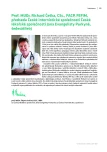-
Medical journals
- Career
A present view on ivabradine in the therapy of cardiovascular diseases
Authors: Jiří Slíva
Authors‘ workplace: Ústav farmakologie 3. LF UK, Praha
Published in: Vnitř Lék 2017; 63(5): 307-310
Category: Reviews
Overview
Cardiovascular illnesses belong to diseases with the highest prevalence. They are also the most predominant reason of death in the vast majority of European countries. Hence, the offer of effective treatment of these diseases is absolutely crucial. This text focuses on the current therapeutical use of ivabradine in its approved indications – chronic stable angina pectoris and chronic heart failure – in the context of so far published relevant clinical trials.
Key words:
angina pectoris – bradines – heart failure – If current – ischemic heart disease – ivabradine
Sources
1. Kannel WB, Kannel C, Paffenbarger RS Jr et al. Heart rate and cardiovascular mortality: the Framingham Study. Am Heart J 1987; 113(6): 1489–1494.
2. Seccareccia F, Pannozzo F, Dima F et al. Heart rate as a predictor of mortality: the MATISS project. Am J Public Health 2001; 91(8): 1258–1263.
3. Palatini P. Heart rate as an independent risk factor for cardiovascular disease: current evidence and basic mechanisms. Drugs 2007; 67(Suppl 2): S3-S13.
4. Diaz A, Bourassa MG, Guertin MC et al. Long-term prognostic value of resting heart rate in patients with suspected or proven coronary artery disease. Eur Heart J 2005; 26(10): 967–974.
5. Tavazzi L. Heart rate as a therapeutic target in heart failure? Eur Heart J Suppl 2003; 5(Suppl G): G15-G18.
6. Lechat P, Hulot JS, Escolano S et al. Heart rate and cardiac rhythm relationships with bisoprolol benefit in chronic heart failure in CIBIS II Trial. Circulation 2001; 103(10): 1428–1433.
7. Fox K, Ford I, Steg PG et al. Ivabradine for patients with stable coronary artery disease and left-ventricular systolic dysfunction (BEAUTIFUL): a randomised, double-blind, placebo-controlled trial. Lancet 2008; 372(9641): 807–816. Dostupné z DOI: <http://dx.doi.org/10.1016/S0140–6736(08)61170–8>.
8. Fox K, Ford I, Steg PG et al. Heart rate as a prognostic risk factor in patients with coronary artery disease and left-ventricular systolic dysfunction (BEAUTIFUL): a subgroup analysis of a randomised controlled trial. Lancet 2008; 372(9641): 817–821. Dostupné z DOI: <http://dx.doi.org/10.1016/S0140–6736(08)61171-X>.
9. Koster R, Kaehler J, Meinertz T. [REDUCTION Study Group].Treatment of stable angina pectoris by ivabradine in every day practice: the REDUCTION study. Am Heart J 2009; 158(4): e51-e57. Dostupné z DOI: <http://dx.doi.org/10.1016/j.ahj.2009.06.008>.
10. Tardif JC, Ponikowski P, Kahan T. Effects of ivabradine in patients with stable angina receiving beta-blockers according to baseline heart rate: an analysis of the ASSOCIATE study. Int J Cardiol. 2013; 168(2): 789–794. Dostupné z DOI: <http://dx.doi.org/10.1016/j.ijcard.2012.10.011>.
11. Werdan K, Ebelt H, Nuding S et al. Ivabradine in combination with beta-blocker improves symptoms and quality of life in patients with stable angina pectoris: results from the ADDITIONS study. Clin Res Cardiol 2012; 101(5): 365–373. Dostupné z DOI: <http://dx.doi.org/10.1007/s00392–011–0402–4>
12. Fox K, Ford I, Steg PG et al. Ivabradine in stable coronary artery disease without clinical heart failure. N Engl J Med 2014; 371(12): 1091–1099. Dostupné z DOI: <http://dx.doi.org/10.1056/NEJMoa1406430>.
13. Swedberg K, Komajda M, Bohm M et al. Ivabradine and outcomes in chronic heart failure (SHIFT): a randomised placebo-controlled study. Lancet 2010; 376(9744): 875–885. Dostupné z DOI: <http://dx.doi.org/10.1016/S0140–6736(10)61198–1>.
14. Volterrani M, Cice G, Caminiti G et al. Effect of Carvedilol, Ivabradine or their combination on exercise capacity in patients with Heart Failure (the CARVIVA HF trial). Int J Cardiol. 2011; 151(2): 218–224. Dostupné z DOI: <http://dx.doi.org/10.1016/j.ijcard.2011.06.098>.
15. Fox K, Komajda M, Ford I et al. Effect of ivabradine in patients with left-ventricular systolic dysfunction: a pooled analysis of individual patient data from the BEAUTIFUL and SHIFT trials. Eur Heart J 2013; 34(29): 2263–2270. Dostupné z DOI: <http://dx.doi.org/10.1093/eurheartj/eht101>.
Labels
Diabetology Endocrinology Internal medicine
Article was published inInternal Medicine

2017 Issue 5-
All articles in this issue
- A present view on ivabradine in the therapy of cardiovascular diseases
- Osteoprotective therapy with bisphosphonates or denosumab in patients with multiple myeloma: benefit and risks
- Thoughts about valvular abnormalities yesterday and today
- What has the GLAGOV clinical study shown?
- News in the treatment of hypertension and dyslipidemia
- Salvation of the diabetic foot through a comprehensive individualized treatment of the patient with type 2 diabetes: case study
- Acute lymphoblastic leukemia of adults – a case of prolonged hip pain diagnostics with a surprising conclusion: case report
- Gastric antral vascular ectasia and solitary rectal ulcer syndrome – two rare diagnoses as the cause of anemia in a single patient: case report
- Is it intestinal tuberculosis again? Case report
- Internal Medicine
- Journal archive
- Current issue
- Online only
- About the journal
Most read in this issue- Osteoprotective therapy with bisphosphonates or denosumab in patients with multiple myeloma: benefit and risks
- Acute lymphoblastic leukemia of adults – a case of prolonged hip pain diagnostics with a surprising conclusion: case report
- Is it intestinal tuberculosis again? Case report
- Thoughts about valvular abnormalities yesterday and today
Login#ADS_BOTTOM_SCRIPTS#Forgotten passwordEnter the email address that you registered with. We will send you instructions on how to set a new password.
- Career

